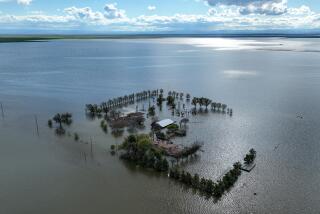Black Sea Venture Aims at a Flood of Questions
NARRAGANSETT, R.I. â In 1994, archeologist Fredrik Hiebert rode around northern Turkey in a dirty white Toyota van looking for evidence of ancient civilizations around the Black Sea.
Every time he and his team would ask locals for the whereabouts of centuries-old ruins, theyâd get the same response. âEveryone kept pointing us to the sea,â Hiebert recalled.
Hiebert now knows why they did. After some preliminary trips, the University of Pennsylvania professor and other scientists will go on a first-ever effort to excavate ancient ships and a possible human settlement left mummified in the Black Seaâs oxygen-free waters.
Scientists hope what they retrieve will help them understand vastly unknown chapters in human history, covering perhaps the Bronze Age, the Roman and Byzantine empires, and when Christianity first made inroads into Russia.
Another goal of the $5-million, two-week expedition beginning Sunday is to find evidence of a great flood about 7,500 years ago that inundated the Black Sea, turning the freshwater lake into a saltwater ocean. Some scholars have said the engulfing could be the Biblical flood of Noah. Others say the theory lacks any scientific premise and complain it could overshadow the more noteworthy experiments that will take place.
The expedition will be watched live by academics and experts worldwide who may be called upon by those on the ship to comment on any discoveries. Schoolchildren also will able to tune in, at Robert Ballardâs Institute for Exploration in Mystic, Conn., and other places.
The so-called âtelepresenceâ is the brainchild of Ballard, the underwater explorer who discovered the Titanic. He has established the Black Seaâs command center at the University of Rhode Island. There, engineers will take satellite feeds from the ship, and broadcast them on a separate Internet channel.
âExploration by its very nature means you donât know what youâre going to find,â said Ballard, 61. âSo, in fact itâs very probable youâre not going to have the right mix of specialists when you make a discovery.â
Ballard chose Rhode Island as the missionâs nerve center because heâll chair a first-ever graduate program in oceanography and archeology beginning in fall 2004. Ballard got his doctorate in marine geology and geophysics from the school in 1974.
The team will be working off the coast of Sinop, Turkey. Scholars have determined it was a major trade hub for centuries. Scientists believe the locals transported olive oil, honey and iron in carrot-shaped shipping jars called amphorae north to Crimea in exchange for wine and other goods.
Hiebert and other archeologists had believed the traders hugged the coast on their routes. But Ballard suggested explorers look for north-south trade lanes in the middle of the Black Sea, which would have been a direct, shorter route for the merchants. He knew the deepest waters had no oxygen, meaning any finds would be in immaculate condition.
Searchers have found four shipwreck sites in previous expeditions. One of them, dubbed âShipwreck D,â is so well-preserved in the Black Seaâs anoxic waters that its hand-carved mast protruding above the seabed looks as good as new.
On this trip, archeologists hope to get a better look at ancient shipbuilding and, if theyâre lucky, some cargo. The ship could contain burlap bags with grapes, a traderâs lunch of lentils, or goods such as silk from Asia, said Cheryl Ward, a nautical archeologist at Florida State University.
âItâs the wood and whatâs inside that is a secret,â said Ward, whoâs leading Shipwreck Dâs study.
At another location about 330 feet underwater, the explorers believe they may have found a settlement that could be more than 7,500 years old. Scientists theorize the rectangular-shaped site was a hunter or fishermanâs house on a bluff overlooking the water before the Black Sea flooded, wiping out the homestead.
Ballard and his team of engineers have built a 7-foot-tall robot named Hercules that will gingerly dig around the ruin and gather artifacts, much as an archeologist would on land.
âIf weâre successful with this, weâre going to change the field of archeology,â said Hiebert, 42, whoâs leading the settlement project. âItâll open coastlines all over the globe [to excavation].â
Scientists also are interested in the ruin, because it could finally clinch the Noah flood theory that has gained the most attention for the trip -- and the most criticism.
Thereâs no dispute that the Black Sea was flooded when rising world sea levels caused the Mediterranean to fill the Black Sea. Prior expeditions show the flood was so monstrous that it raised water levels by 511 feet and submerged up to 60,000 square miles of land, an area the size of Georgia.
The questions are when did it happen, and how rapidly? Until recently, scholars believed the drowning occurred about 9,000 years ago and was gradual.
But marine geologists Walter Pitman and William Ryan wrote in 1997 that the flood was sudden and took place about 7,150 years ago.
The scientistsâ conclusions reinvigorated the Noah flood debate, which the Bible chronicles as a calamitous event spanning 40 days and 40 nights.
Scholars are wary of the revised theory, saying itâs virtually impossible to prove an event from an ancient text.
Also, some scholars note that the Bibleâs version has Noah living in a desert in Mesopotamia, while the pre-flood coastline of Turkey was a lush, forested area.
âIt bugs me a little bit,â Hiebert said, âbecause I like the Noah story as much as anybody. I think we shouldnât try and peg what weâre doing to either prove or disprove it. Weâre never going to get there.â
Nevertheless, even skeptics such as Hiebert acknowledge the debate has given the expedition more attention than it would have gotten otherwise.
âI wish all my classes had a million and a half people in it,â he joked.






